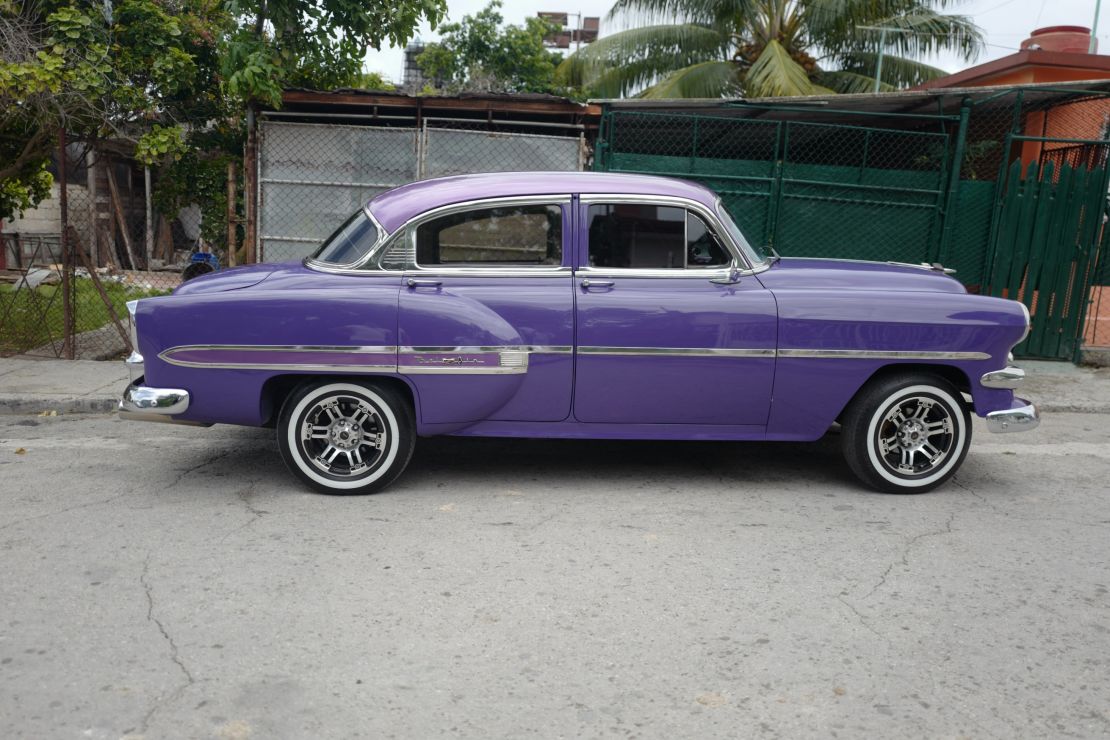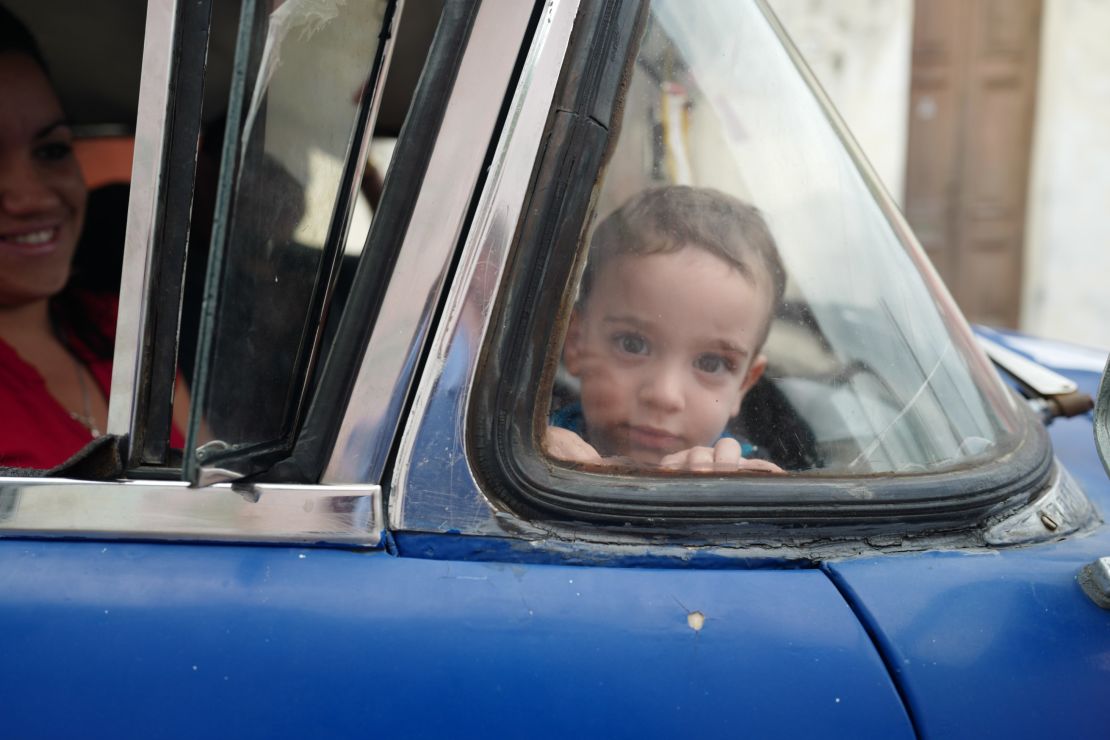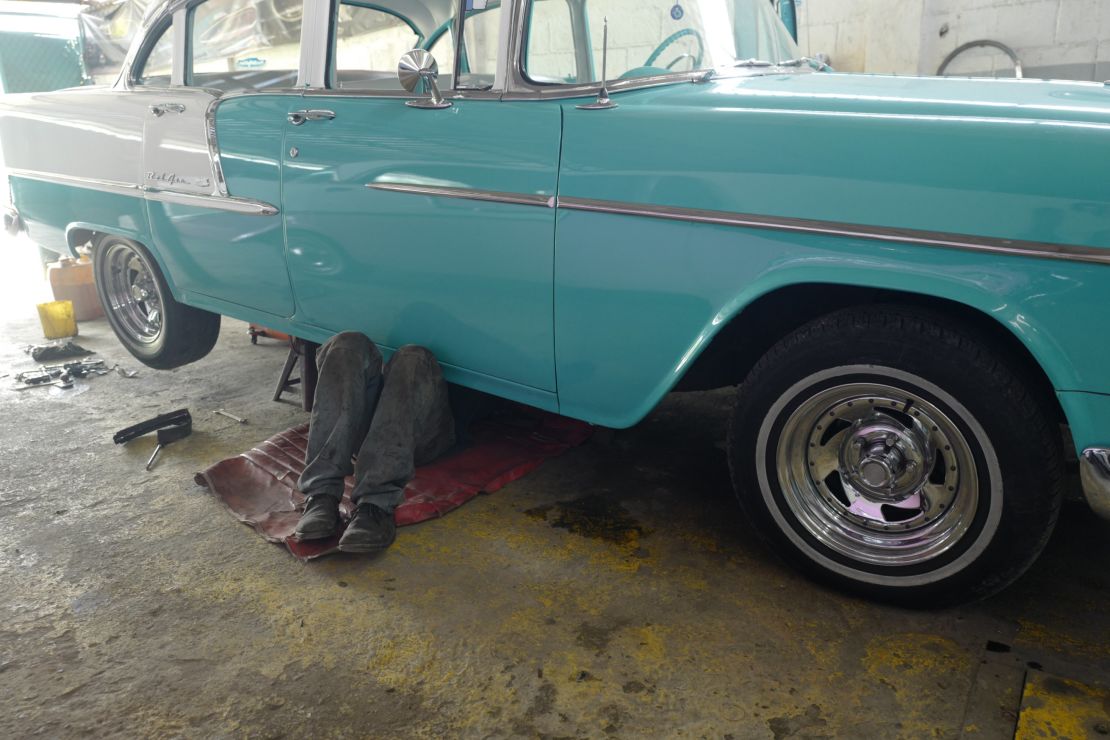The doors of the rusted container that Roberto uses as a garage in the working-class Havana neighborhood of Mariano groan as he shows me the treasure hidden inside: a purple 1954 Chevy that shines as if brand new.
Roberto says he found the car out in the provinces and has spent the last two years restoring the Chevy to its former glory so he can now sell it. His asking price: $34,000, a fortune in Cuba.
Many of the car parts that Roberto needed he was unable to locate on Cuba’s black market so he paid “mules,” the Cubans who travel back and forth to the island carrying hard to find items, to smuggle in the pieces. “We got most of this off eBay,” Roberto says, popping the hood to show me the brand-new engine block inside. Roberto insists we go for a test drive.
Technically Cubans can only sell cars to other Cubans, but Roberto doesn’t seem to think there’s anything strange about an American like me shopping for “un carro clásico.” Apparently all kinds of people are interested in buying from the Cuban car market these days whether it’s legal or not.
We speed off and in just a few minutes the car’s new air conditioning system chills the Chevy to a deep freeze. A screen mounted on the dashboard blasts reggaetón music videos on a loop. Across the back window, Roberto has inscribed “lo más tigre” – loosely translated, “the fiercest.”
I tell Roberto I can’t believe he really wants to sell the Chevy after putting so much work into it. “I have to,” he responds, “I need the money to fix up two more cars I am buying!”

When I first came to Cuba for work 1998, there were more Chinese bicycles on the road than classic American cars. I often pedaled a Flying Pidgeon model single-gear to get to work.
American cars then were considered something of a burden; gas guzzlers whose parts were impossible to replace thanks to the US economic embargo, which makes most commercial transactions with the island illegal, and has effectively limited ties between the US and communist-run Cuba for much of the last half-century.
Some of the smoke-belching monsters had so many adapted Chinese and Russian parts inside that Cubans nicknamed them “Frankensteins.” They were rusty beasts that almost no one thought about painting or fixing up. Few people could afford to do much else but keep them running.
But as tourism to the island increased and the island’s government loosened restrictions on travel and car ownership for Cubans, more and more mint-condition beauties emerged from their long state of abandonment. Cuban entrepreneurs realized there was money to be made in offering vintage car tours and fanned out across the island in search of old cars to repair and fill with paying customers.
Now nearly every hour of the day, a line of classic cars, as brightly colored as the frosting on a birthday cake, parade down Havana’s seafront Malecón esplanade, with a thicket of tourists’ selfie sticks protruding from the back seats. Many of the tours begin in Old Havana, the partially restored colonial section of the city, and drive past the ruined, crumbling apartment buildings in Centro Habana to the formerly glitzy hotels of the 1950s that dot the seafront, where the American mob once held sway.

The image of the American touring Havana in an old car has become so ubiquitous that a poster by the Cuban artist Ares shows the Statue of Liberty cruising through Havana the back of a convertible taxi, taking her own picture with an iPhone.
While it’s still illegal for Americans to travel to Cuba as tourists under US law, in 2015 former President Barack Obama changed regulations to allow 12 categories of permitted travel, opening the floodgates. For the first time since the Cuban Revolution, Americans could travel to the island and US airlines and cruise ships reestablished service to Cuba. Suddenly there were large crowds of American visitors teeming the streets of Havana and lining up to ride in the old cars.
The going rate for tourists to ride in a classic car is $30 an hour, or about the same as what a Cuban doctor makes in a month. That kind of cash has led Cubans to search the island for old cars to fix up, and created a lifetime of work for the restorers who breathe new life into them.
Joani Cardenas paints cars at his workshop in Guanabacoa on the outskirts of Havana, and is considered one of the best at stripping down and restoring the old cars. The lot behind his house is crowded with Russian, Chinese and American cars awaiting his expertise. The number of car parts scattered across his workshop and backyard suggest a recent 10-car pile-up.
While nearly every Cuban is by necessity an amateur mechanic, Cardenas takes car restoration to a different level. His specialty is completely disassembling each car so he can paint every piece individually. Classic American cars take him the longest, sometimes requiring two months to restore.
“American cars are more work, the bumpers are much bigger,” Cardenas said. “The lines are different. But everyone now wants to buy American cars and have them painted.”
After so many years Cubans, have retained an affinity for the old American cars. It’s not an uncommon thing here to see guys in their 20s ogling a 1950s-era Ford as if it were a Maserati.
But the driving force for the rebirth of old American cars in Cuba is economics. There are classic British Land Rovers and Russian Ladas in Cuba too, but it’s the American cars that tourists want to have their pictures taken in.

Now that I’ve lived in Cuba for more five years as CNN’s correspondent and Havana bureau chief, one of the questions I’m asked most often is if I ever get used to seeing all the old cars. The answer is no.
I could never take Cuba’s cars for granted as long as I keep coming across prized models of DeSotos and Hudsons that have all but disappeared from the streets of every other country in the world. It’s easy to fall in love these cars that possess a style and vision that automakers lost long ago. Nearly every day I find myself marveling at a gleaming testament to Cuban ingenuity and perseverance rolling down Havana’s pockmarked roads.
Nidialys Acosta Cabrera’s company NostalgiCar is one of many that sells foreign visitors classic car tours. Her company has four 1950s cars on the roads and is busy restoring another six vintage automobiles to meet the demand.
“Already in this garage we have 14 employees,” she said. “Before we ran it all out of my house. So we have grown a lot and it’s all been thanks to the increase in tourism.”
But Acosta Cabrera is worried President Donald Trump’s hardening policy towards Cuba will lead to less Americans visitors and, subsequently, less income for her and her employees. Still, she hopes the movement to rescue Cuba’s classic cars can forge ahead.
“For every one tourist who comes here, riding in an old car has become something traditional and symbolic,” she said. “If you don’t do it, it’s almost like you didn’t come to Cuba.”









